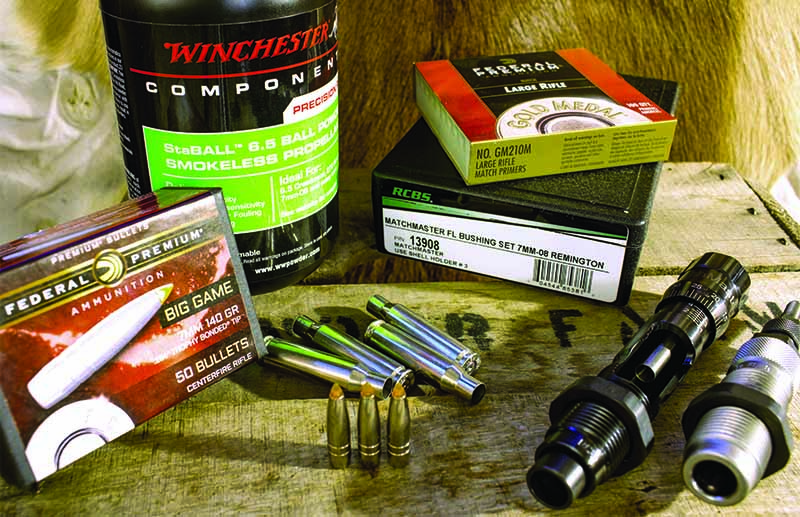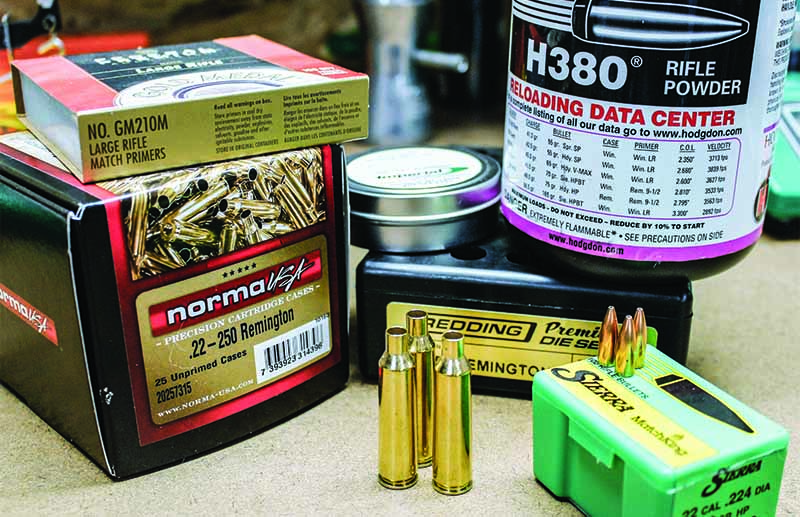
A couple decades ago, I bought a rifle which would become—and remain—my dedicated varmint rifle. It’s a Ruger Model 77 MKII in .22-250 Remington, with a sporter-weight 22-inch barrel, a Hogue over-molded stock and Timney trigger. While the accuracy wasn’t terrible with factory ammunition—though the factory trigger was a different story—I wasn’t getting exactly what I wanted from handloads, predominately using IMR4064 and IMR4320. Both of those powders were chosen because I had them on hand from years of loading for my .308 Winchester and because they sat in the middle of the burn rate choices for the .22-250 case.
Speaking to some guys who I knew were serious about the .22-250 as a target cartridge, they enlightened me. “Look no further than Hodgdon H380; anything else and you’re wasting your time.” Well, alrighty then.
Off I went to purchase a pound of H380. Their recommendation made sense, as H380 was named for Bruce Hodgdon’s 38-grain load in the .22-250 with a 55-grain bullet. I immediately saw a huge accuracy improvement, but more importantly, it was my introduction to ball powders and how useful they can be.
Powder Geometry
There are predominately three powder shapes: flake, extruded stick and ball, or spherical. The flake powders are generally reserved for shot shells and pistol cartridges, and among rifle cartridges, the stick powders greatly outnumber any of the ball powders. There are some times where a ball powder comes in very handy, solving some problems where case capacity is limited.

I remember loading for my dad when we were heading to Tanzania for Cape buffalo and having trouble getting his .458 Winchester Magnum to reach anything close to what the velocities were supposed to be. With 500-grain A-Square Dead Toughs and Monolithic Solids, real estate inside the case was assuredly at a premium.
After several unsuccessful attempts with stick powders, it was finally Hodgdon’s H335 that got me where I needed to be: 2,080 fps, and groups hovering around 1½ inches at 100 yards. While normally associated with the .222 and .223 Remington, it works well in the larger, straight-walled cartridges as well.
Speaking of dad and his straight-walled cartridges, I leaned on a ball powder for his .45-70 Government when we headed to South Dakota to hunt bison. His rifle is a Browning 1886—definitely a strong action—and we wanted to take advantage of that fact. Using a 400-grain Swift A-Frame and 58.0 grains of Hodgdon’s BL-C(2), that 26-inch octagon barrel gave a muzzle velocity of just over 1,800 fps; Dad took his bull cleanly with a well-placed shot.
That load, while on the stout side, is plenty accurate for the iron-sighted lever gun. BL-C(2), pronounced ball-see-two, was designed for the 7.62 NATO, so the .308 Winchester is a natural candidate for this ball powder, but it also works very well in the smaller cases like the .204 Ruger, .223 Remington and even the .17 Remington.
Hodgdon’s H414 is a slower-burning ball powder with a burn rate similar to H4350 (though not interchangeable), which is ideal in the .30-06 and similar cases; I’ve had fantastic results in the 9.3x62mm Mauser and in the .375 H&H Magnum. Some folks say this powder (which is very, very close to Winchester 760) is sensitive to temperature change, though that hasn’t been my experience: It has been rather consistent in summer and fall temperatures.
Getting back to good ol’ H380, that powder has been good to me, though I can testify to the temperature sensitivity … to the point where I use a summer load and a winter load. In spite of the temperature issues, it’s accurate, not only in the .22-250 Remington, but in the .308 Winchester — my rifle loves H380 and a 165-grain Sierra GameKing hollow-point boat-tail — and in the .375 Ruger.
Winchester has long been famous for their ball powder lineup, with W748 and W760 being highly popular. A friend has a Remington 700 Classic chambered in the now-obscure .350 Remington Magnum, and if any cartridge is cramped for space, it’s that one. Having gone through a number of powders, W748 came to the rescue for that gun, and under a 220-grain Speer Hot-Cor bullet it has MOA accuracy, and velocities with an extreme spread of around 20 fps.
The New StaBALL
Winchester has released a new ball powder, the StaBall 6.5 powder, which is well-suited to a number of cartridges. Named for the 6.5 Creedmoor—the burn rate sits comfortably between H4350 and Reloder 19, making it a perfect choice for the Creedmoor family. Plus, this powder is engineered to be insensitive to temperature swings.

Winchester (Hodgdon) offers data for a wide range of cartridges, including classic varmint cartridges like the .22-250 Remington, .220 Swift and .257 Roberts, up to the mediums like the 7mm-08 Remington, 7×57 Mauser and .30-06 Springfield, up through the big bores like the .375 Ruger, .375 H&H, .416 Remington Magnum and .416 Rigby.
I wanted to see how it would perform in a couple of different cartridges. My pal, Mike Buser has a great 6.5 Creedmoor—a Masterpiece Arms Custom—so we loaded up some StaBall and a pair of bullets we knew the rifle liked: the 140-grain Berger Hybrid and the 135-grain Hornady A-Tip. The Winchester load data claims velocities higher than most other powders, and we found that claim to be true, though the test barrel was 2 inches shorter than Mike’s barrel. We drove that 140-grain Berger to an average velocity of 2,745 fps, with 100-yard group sizes between 0.51 and 0.70 MOA. The 135-grain A-Tip left the barrel at 2,840 fps, averaging 0.65-MOA, with extreme spreads hovering around the 20-fps mark.
My Tikka T3X Lite in 7mm-08 Remington likes StaBall also. The 140-grain Federal Trophy Bonded Tip, over a charge of 47.5 grains of StaBall, gave 2,835 fps into just under 1-MOA groups. With a bullet of this construction and conformation, there aren’t too many species that are off the menu. The load data indicates that the 7mm-08 can push the 175-grain Nosler Partition to over 2,600 fps with StaBall 6.5; I got 2,615 fps with three-shot groups printing 1.1 inches at 100 yards. Those 175s are certainly long and can eat up a bunch of room inside the case; using a ball powder will help combat that fact.
Bat or Ball?
Do ball powders beat the extruded stick powders? Because there are so many more choices in stick powder, I feel pretty confident saying that they’ll remain at the top of the heap. However, there are many instances where they can provide the answer to the problem of limited case capacity.
When space is limited, and the load density exceeds 100 percent, you can break the grain structure of stick powder due to over-compression. This can have negative effect on consistency, where using a ball powder will give less air gaps and reduce the space occupied by the powder column. If you like the smaller cases, give one of the ball powders a try … you might just develop a new favorite for you and your rifle.
Editor's Note: This article originally appeared in the January 2021 issue of Gun Digest the Magazine.
Get More Reloading Info:
- Tips For Reloading the .30-06 Springfield
- Loving Your Luger: Reloading the 9mm Luger
- Handloading: Tips For Reloading The 7mm Rem Mag
- How To: Tips For Reloading the .223 Remington
- Reloading Bench: The Inside On Reloading For The .30-30 Winchester

Next Step: Get your FREE Printable Target Pack
Enhance your shooting precision with our 62 MOA Targets, perfect for rifles and handguns. Crafted in collaboration with Storm Tactical for accuracy and versatility.
Subscribe to the Gun Digest email newsletter and get your downloadable target pack sent straight to your inbox. Stay updated with the latest firearms info in the industry.

![Best Concealed Carry Guns In 2025 [Field Tested] Wilson Combat EDC X9S 1](https://gundigest.com/wp-content/uploads/Wilson-Combat-EDC-X9S-1-324x160.jpg)


![Best 9mm Carbine: Affordable PCCs [Tested] Ruger Carbine Shooting](https://gundigest.com/wp-content/uploads/Ruger-Carbine-Shooting-100x70.jpg)
![Best AR-15: Top Options Available Today [Field Tested] Harrington and Richardson PSA XM177E2 feature](https://gundigest.com/wp-content/uploads/Harrington-and-Richardson-PSA-XM177E2-feature-100x70.jpg)

1800 FPS for a 400 grain bullet out of a 45~70 is a little more than “stout!” I’m driving a 340 grain cast & powder coated LEE bullet at 1600 FPS & if I don’t tuck-in correctly, the sting is punishing. I’m using Hodgdon 4198 but when I went past 40 grains the recoil was so monstrous that the extra velocity just wasn’t worth it.